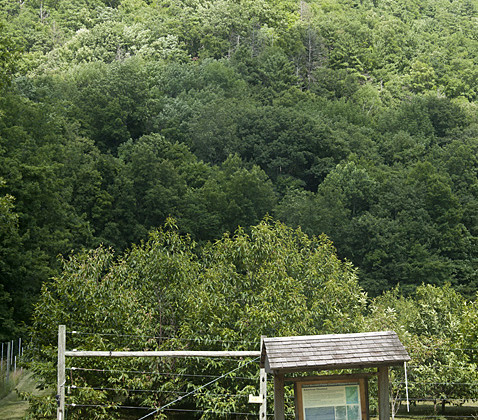Rebuilding the American Chestnut Tree
Rescuing a Forest Icon
By Ruth Melville
From Connecticut to Mississippi, along the Appalachian Mountains and into the Ohio Valley, the American chestnut tree, able to grow as big as 130 feet tall and 10 feet in diameter, once dominated the forest canopy. Although American chestnuts were almost wiped out by disease by 1950, promising efforts to breed disease-resistant trees mean that we may once again see these magnificent trees in our New England forests.
Not only were American chestnuts a significant feature of the landscape, they were a major ecological resource. Hans Carlson, director of Great Mountain Forest (GMF), says, “The wood was fantastic, and the nuts were a huge source of protein, for people and animals, especially in the Appalachian region.” The trees were so highly prized by Native Americans that they selected for them. It is estimated that at the time of contact, when Europeans first arrived, one out of every four trees was a chestnut. The straight, rot-resistant and easily worked hardwood was used for countless purposes, including masts, house construction, furniture, railroad ties, and telegraph and telephone poles.
The reign of the American chestnut ended with the arrival of the chestnut blight at the beginning of the twentieth century. The blight is caused by Cryphonectria parasitica, a parasitic fungus that forms a canker on the tree which kills the layer of bark that carries water and nutrients. Eventually the tree dies. Spores from the canker spread the blight to other trees.
The fungus was carried to the United States on imported Chinese chestnut trees. The Chinese trees were resistant to the blight, but not the American ones, and the disease quickly spread among the native trees. By the 1950s almost all the American chestnuts along the East Coast were dead or dying, around four billion trees over nine million acres. Efforts to stop the spread of the disease—mostly by cutting down trees—were unsuccessful.
Although you can still find chestnuts in the Norfolk woods, they are only able to grow to a certain size—about 20 to 30 feet high—before succumbing to the disease.
In 1983 the American Chestnut Foundation (ACF) was founded with the goal of restoring the chestnut to the eastern forests. ACF set up a breeding program to try to preserve the desirable qualities of the American chestnut while introducing disease-resistant genetic material from the Chinese trees. The first step was to cross a Chinese chestnut with an American chestnut. In subsequent breeding cycles, the offspring are tested, and the resistant trees are then “backcrossed” with another American chestnut. Three generations of backcrossing yield trees that are 15/16 American chestnut.
A second front has recently opened in the war on C. parasitica: gene therapy. Scientists hope to take a gene in wheat that combats the oxalic acid produced by the fungus and insert it into American chestnut embryos.
To achieve healthy genetic diversity and to allow for local adaptation, ACF has breeding orchards in all the states of the American chestnut’s original range. Star Childs has recently been elected president of the Connecticut chapter.
The largest plantation of 15/16 chestnuts in the Norfolk area is in Falls Village, under the management of Ellery “Wood” Sinclair. The plantation was planted in 2006, on land provided by GMF. The orchard covers two acres up against Canaan Mountain and has 250 trees. Volunteers from GMF and the Connecticut branch of ACF, and students from Housatonic Valley Regional High School, where Sinclair used to be head of the English department, helped plant the trees.
GMF has a long history with the efforts to combat the chestnut blight. In the 1940’s Edward C. “Ted” Childs had a plantation of chestnuts on Canaan Mountain, and Sinclair remembers picking chestnuts there. According to Carlson, the plantation was closed in 1978, when all the trees were dead.
Wood Sinclair has been fascinated by chestnuts since boyhood. On his property in Falls Village, which has been in the family for generations, he has a chestnut cabin built during the Depression from dead chestnut logs. Every year he leads a Housatonic Heritage Walk through his orchard, after which he shows participants pieces of furniture and boxes handmade from chestnut wood, and his wife, Marylu, serves chestnut cookies.
“The loss of so many trees in such a short period of time was an ecological catastrophe from many points of view,” Sinclair says. He hopes that his efforts, and those of many others, will eventually lead to the restoration of this iconic tree to our landscape.
Photos buy Bruce Frisch.


